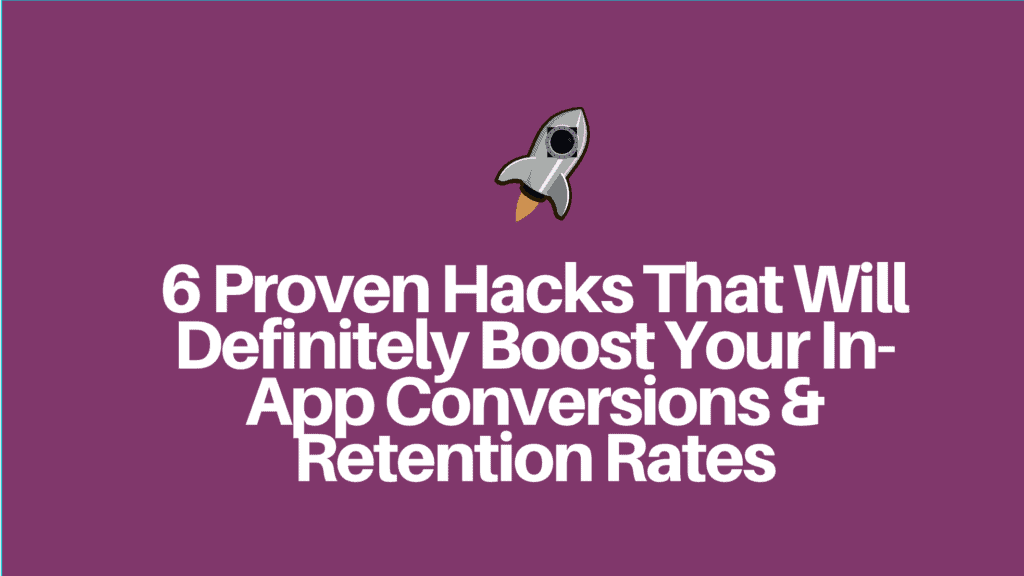83% activation rate, 45% free trial conversion rate. I figured out how to boost in-app conversion and retention rates. Keep reading to know the story and hacks below.
But should you listen to me anyway? Yes, and here’s why:
I myself have been a founder of a company twice now.
I’m currently the Head of Growth at Userpilot
I am currently advising more than 4 SaaS companies on topics very much like this article.
I have helped more than 500 companies when it comes to improving their activation, engagement and conversion rate.
All of the information i’m giving you is born from either my own personal experience as someone in this field for so many years, or from my own endless research; my 2020 Product Onboarding report being one of many.
Before going further, if you like watching than reading you can see my session ?
Userpilot helps teams increase user adoption by allowing them to trigger the right in-app experience to the right persona at the right stage of their user journey.
Hack #0
Before we even get to the main points, this is a bit of wisdom that must be shared and it should definitely help.
Talk to your users, regardless of the stage.
It doesn’t matter if you’re pre or post product market fit. I would strongly encourage you to talk to you users on a regular, weekly basis. I may not have numerical, quantitative data to present for this, but it has definitely helped me over time.
Think of it like research of your own. Understanding your users helps you improve your marketing skills as a whole; messaging, copying, you name it!
There’s another point to consider if you’re starting out: don’t think about scaling. It can be detrimental if you’re too early. It’s the wise advice of Paul Graham, and we should all follow it.
Don’t think about scaling your email onboarding so soon, about scaling your sales process so soon. You’re missing out a valuable learning opportunity. Focus your energy on talking to your users instead, learn what they’re saying. Why should you bother? You should because it’s all about understanding your user’s journey.
Journeys are a whole process and you need to put yourself in your user’s shoes. Start thinking about them even before they come to your landing page; what is the problem that you’re solving and how can they benefit from it? So when they do come on your landing page, that leads to how you can help them. How can you help them acquire that special set of superpowers! Each software company has some sort of superpower or the other, which you give the user to enable them to do many, many things.
If you’re able to understand that user journey, you have a high chance of converting them.
Conversions come second, solving user problems always comes first!
And remember! Always set the right expectations.
If you still haven’t achieved product market fit, i would highly recommend just being honest. If your user enters your application, it should be clear to them that you’re still improving. Just see what it did for Julain Shapiro:

Don’t try to fool the system. Just be genuine and that always helps.
That ‘Aha!’ Moment: Activation
Conversion is all about the ‘Aha!’ moment and activation. When a user steps into a SaaS product they have 2 concerns:

What does the platform do?
The answer to this question is what brings about that ‘Aha!’ moment.
How can the platform help them achieve what they want to do?
If the answer to this question is positive, this is one step closer to activation.
Let’s put this into context: maybe your product is a social media tool that will help the user schedule. Once the user starts using it, starts scheduling and positing, and they realize that they save time, that is an activation moment; when your user understands the value of your application.
Think about Facebook, the social media application that everyone knows so well. It’s promise was to connect you to your friends online and when users found that to be valuable, that turned into activation for Facebook.
The difference between the two is important because you need to optimize for both- the ‘aha!’ and the activation- when looking into boosting conversions.
Hack #1: Add a Welcome Screen
The first impression is key.
My research has found that 40% of SaaS products don’t have welcome screens for new users, and they just directly take the user in. I would recommend against that. You need to present something like a pop-up model, which tells the user to take an action.
Protip: Just have 1 action if it’s a linear onboarding. Just directly take them to the activation. Don’t show them product tours, and don’t explain what every tool does; the user doesn’t want that. I say this because of the following pop-up model:
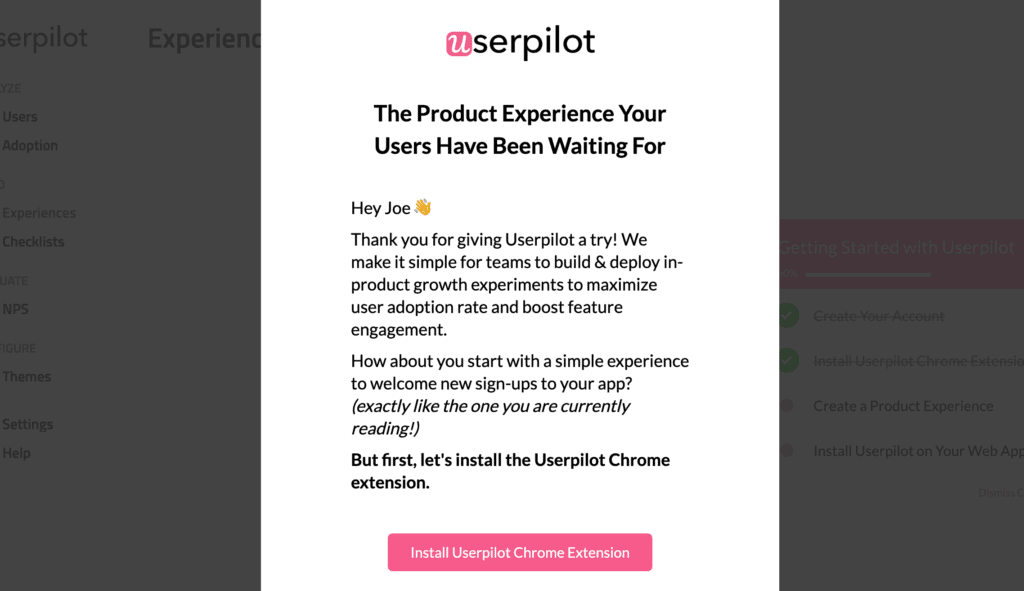
This is Userpilot’s pop-up model and we have seen that 83% of users activated through this, because all they wanted was to install the chrome extension. Hence i would highly recommend to just go to the activation part.
This subsequently increased the amount of people using the application. It helped them understand the ‘aha!’ and the value much faster. They understood that Userpilot was dedicated to assisting them in user onboarding.
Now product tours, checklists, application assistance can all come after but i would always say to go for activation first, so that the user gets to decide their action as soon as they come to the landing page.
Hack #2: Add Contextual Onboarding
Contextual onboarding is something many SaaS companies don’t do.
Common practice is to bring the user to the welcome screen, onboard them and then leave them to their own devices to explore. It’s actually great that users are left freely, because you don’t want to irritate your user by bugging them. However, you need to look at what exactly they are doing in your application.
Going back to our example of social media tools for scheduling. You can guide your user through the process of creating a post, great! When that’s done and dusted, you should also suggest what else they can do based on what they have already done.
Hubspot is a great example for this. I was a free user, having downloaded their chrome extension. One day I was using it on Gmail, and I was copy pasting when suddenly i received the following pop-up.

Now templates are a paid feature and I was a free user. But they struck at a great moment and I could tell that Hubspot showed me this feature when they saw that I needed it. That is a practice that 72% of SaaS companies don’t follow.
You need to take the users to the next step after seeing what they do.
Custom Events and how to use them
A lot of applications have custom events data in their database but they tend to not pass it on to their onboarding tools.
A custom event is when a user comes into an application, does something, and you record a mention of what they did. The reason for recording this, is so that you can send them a customized email, a customized event pop-up, etc.
Keeping track of what your users are doing in your application is also greatly beneficial in terms of analytics.
As a Growth Manager or a Product Manager, you need to know where the user is in their journey. Let’s walk through the following diagram, using our running example of a social media tool for scheduling:
Your initial ‘Aha!’ moment is when you connect the user to the social media tool. Now they know what it is. They’ve learned about it on the landing page and now they see it after having connected with it.
Now you want them to get activated, and for that they need to create a social media post. They go through their journey of creating and scheduling their posts and this use shows you that they have been activated.
It’s great to connect these two ideas together. Once your user has their ‘Aha!’ moment, you can guide them into creating their first social media post, and subsequently you’re leading them in the activation moment. We do it too as soon as someone installs our code.

After this, you can show different social media features. Maybe you have gifs, maybe you have discovery features. This is an advanced level and is considered to be a secondary feature adoption. This is all part of your user’s journey in your application.
And how do you turn your users into champions? Custom onboarding based on where they are in the onboarding web.
I would highly recommend using custom events.
Hack #3: Add Personalized Onboarding
Personalization is key when it comes to creating an authentic user experience and establishing a sense of trust.
What describes your user?
What is your user’s goal?
If you don’t ask anything, your user experience will be very standard across the board, which isn’t very appealing.
Here’s a great personalized onboarding example from Notion:
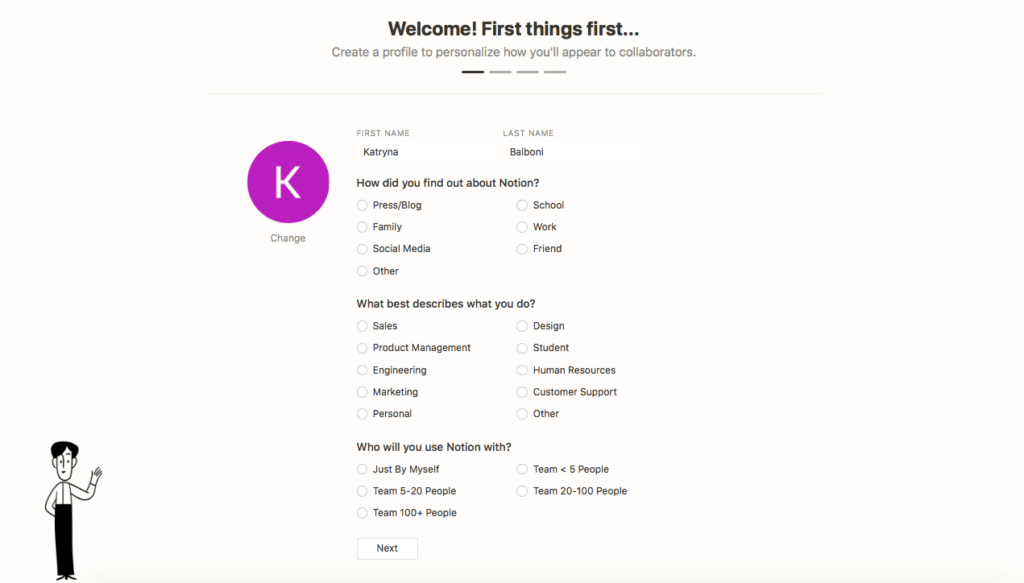
They’re asking their users what they do. Once the user makes their selection, Notion presents a template accordingly. That’s a powerful move, because once you understand who your user is then you can personalize the email journey, activation moments, you name it!
Now that was one way. Another way you can know your user is through their goals. Understand what they want and then take them to that path.
This will increase your conversions, at the activation point. Maybe your application is a little complicated? Well then this personalization will simplify it a little for the user and this will nudge them into converting.
I practice this a lot in my own work (eating my own dog food as they say). I look at what my users do, create a custom event, and I send them personalized messages.

I look into whether the user has installed the Chrome extension, and has installed our Userpilot Javascript. I follow this information with an email, an email which is personalized according to their goals and has a video-based message. We received good numbers, with 60% of users opening it and 8.3% clicking on the link; good numbers to take them to the next step.
However I also added more personalization by pushing them to an onboarding call. That helped my numbers skyrocket, from 8.3% to 60%. I ended up seeing 60% of my users book an onboarding call, which is huge!
You can add this to your sales email or your automated email. The idea is to know where the user is in the application and where you want them to be. It’s great for conversions.
Corey from Baremetrics reached out to me with a personalized email, sending me a short demo of Baremetrics using my own actual metrics.

He sent it to so many people, not just me.

It was a brilliant video and this is a brilliant unscalable way of Personzalition. He told me that his video-open rate was 60% and his response rate was 20% which is absolutely great!
Hack #4: Add Milestones, Checklists or Success Celebrations
These you MUST add!
In our research, we found out that only 17% of applications celebrated their users’ milestones and achievements.
Here’s an example of how Apollo Enterprises does it, in their own fun way

What’s disappointing is that so many companies don’t do this.
We also found out that 46% of SaaS companies don’t use checklists. Now checklists are used to add milestones and improve activation rates. Let’s look at SkedSocial?
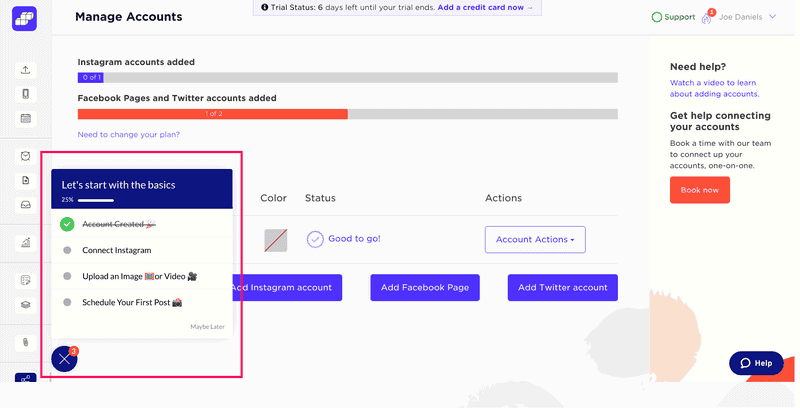
They saw that, as soon as they added a checklist to their application, if people clicked on the checklists and completed them, SkedSocial ended up converting 4 times more users than before. It’s a dynamic checklist which connected the user’s journey so they naturally had a lot of conversions from there.
Think of it like an activation point. It’s a point where users understand the basics and understanding basics means that they’ve understood the value of your application.
So yeah. Create a checklist in your application.
On the topic of checklists, I learned something new from this podcast. Reyana Fayez talked about taking the checklist one step further; she added gamification:
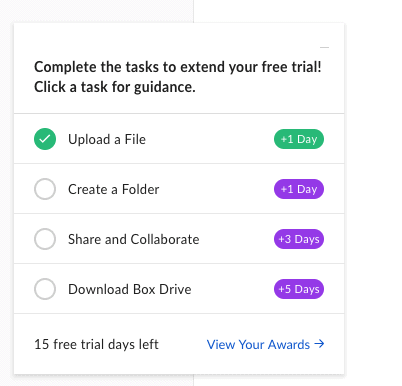
The added incentive and rewarding users led more people into turning into paid users. It could be more trial days, or a discount code on finishing the checklist.
I would highly recommend this too, especially since a lot of SaaS companies don’t do this and having done it will give you a competitive advantage.
Hack #5: Connecting In-App with Out-App
Your in-app events should be aligned with your out-app event via emails.
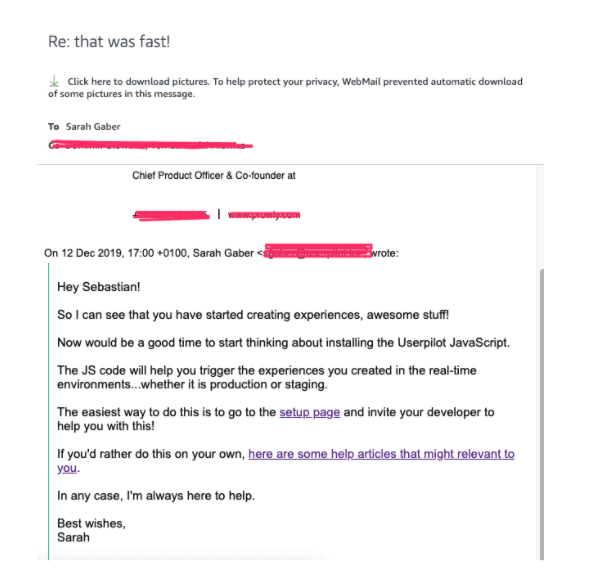
Look at this above email as an example. This looks like a personalized email but it’s actually automated. It’s simply responding to user activity in the application- in this case it is when a user has installed Userpilot’s Javascript- but it looks like it was made for the user, because of the timing. We also got a 70% response rate on this, with users reaching out with their questions and concerns.
In our research, we discovered that 88% of Saas products did not send emails based on in-app triggers.
Now the companies that do send emails, we’ve seen their templates. However, at Userpilot, we decided to change it up with the following ideas:
We have a decency rule. We only send emails on weekdays, not on weekends.
We sent these emails based on in-app events.
We send these emails from a normal, personal account, rather than a company account.
We do not have unsubscribe links in our emails, so they look quite natural.
In accordance to GDPR, users need to get the option of unsubscribing. So we simply replaced the link with text that if a user wants to unsubscribe, they can reach out to us and do so. It looks like a normal person talking to them rather than a computer automation, which is the goal.
We want our emails to go to primary inboxes, not promotion inboxes.
Emails are person to person and you want them to then look like they came from a person.
Hack #6: Use Interactive Walkthroughs
Don’t use product tours. I’m serious, don’t do it.
Now in our research, we found out that:
- 29% of SaaS companies use product tours.
- 71% use nothing.
- 24% use interactive walkthroughs.
Your user isn’t interested in all your fancy buttons and features. Their primary concern is how your application can solve their problems and that’s what you need to show them.
Now one of our clients was kind enough to let us use their numbers to show you that interactive walkthroughs do work after all ?
They saw that areas where users had to do something- either they had to click on something or write something- those areas received better engagement and hence made users likely to complete the flow and get converted. Users want to take action, that’s what they’re in your application for.
Check out this cool interactive walkthrough by our customers stripo.email.
Some More Advice…
If you have a product, do not send the user a confirmation email and then take them to the application. Instead take them to the application directly and allow them to confirm in the application through a banner. The problem doesn’t lie in sending them an email, it lies in the fact that these emails sometimes end up in the spam folder and if your user can’t find the confirmation email, then they can’t get converted.
I wanted to mention this just in case, despite this advice being repeated multiple times by other people.
What Now?
If these hacks helped you, I would strongly urge you to adopt them in your SaaS product or application. Taking your time with them and putting effort will definitely boost your conversions.
If you’re still interested in learning more, join ourProduct Adoption School.
Or maybe just try Userpilot or any other onboarding tool to quickly fix your mistakes. You can have welcome screens, trigger events, checklists, and interactive walkthroughs in just a few minutes.

